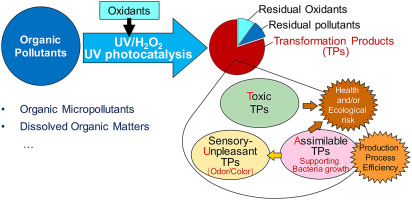Water Research ( IF 11.4 ) Pub Date : 2018-05-15 , DOI: 10.1016/j.watres.2018.05.005 Wen-Long Wang , Qian-Yuan Wu , Nan Huang , Zi-Bin Xu , Min-Yong Lee , Hong-Ying Hu

|
UV based advanced oxidation processes (UV-AOPs) that efficiently eliminate organic pollutants during water treatment have been the subject of numerous investigations. Most organic pollutants are not completely mineralized during UV-AOPs but are partially oxidized into transformation products (TPs), thereby adding complexity to the treated water and posing risks to humans, ecological systems, and the environment. While the degradation kinetics and mechanisms of pollutants have been widely documented, there is little information about the risks associated with TPs. In this review, we have collated recent knowledge about the harmful TPs that are generated in UV/H2O2 and UV photocatalysis, two UV-AOPs that have been studied extensively. Toxic and assimilable TPs were ubiquitously observed in more than 80% of UV-AOPs of organic pollutants, of which the toxicity and assimilability levels changed with variations in the reaction conditions, such as the UV fluence and oxidant dosage. Previous studies and modeling assessments showed that toxic and assimilable TPs may be generated during hydroxylation, dealkylation, decarboxylation, and deamination. Among various reactions, TPs generated from dealkylation and decarboxylation were generally less and more toxic than the parent pollutants, respectively; TPs generated from decarboxylation and deamination were generally less and more assimilable than the parent pollutants, respectively. There is also potential concern about the sensory-unpleasant TPs generated by oxidations and subsequent metabolism of microorganisms. In this overview, we stress the need to include both the concentrations of organic pollutants and the evaluations of the risks from TPs for the quality assessments of the water treated by UV-AOPs.
中文翻译:

UV / H 2 O 2氧化和紫外线光催化的潜在风险:有毒,易吸收和感觉不适的转化产物综述
在水处理过程中有效消除有机污染物的基于紫外线的高级氧化工艺(UV-AOP)已成为众多研究的主题。大多数有机污染物在UV-AOP期间并未完全矿化,而是被部分氧化成转化产物(TPs),从而增加了经处理水的复杂性,并对人类,生态系统和环境构成了风险。尽管已广泛记录了污染物的降解动力学和机理,但有关TP风险的信息很少。在这篇综述中,我们整理了有关UV / H 2 O 2中产生的有害TP的最新知识。和紫外线光催化,这两个已被广泛研究的紫外线AOP。在超过80%的有机污染物UV-AOP中普遍观察到有毒和可吸收的TP,其中毒性和可吸收水平随反应条件(例如UV通量和氧化剂用量)的变化而变化。先前的研究和模型评估表明,在羟基化,脱烷基,脱羧和脱氨基过程中可能会产生有毒和可吸收的TP。在各种反应中,脱烷基和脱羧产生的总磷通常分别比母体污染物毒性低和毒性更大。由脱羧和脱氨基产生的总磷通常分别比母体污染物少和更易吸收。人们还担心由微生物的氧化和随后的新陈代谢产生的感觉不适的TP。在此概述中,我们强调需要将有机污染物的浓度和对总磷风险的评估都包括在内,以便对经UV-AOP处理的水进行质量评估。











































 京公网安备 11010802027423号
京公网安备 11010802027423号